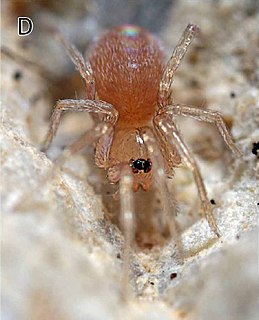
Oonopidae, also known as goblin spiders, is a family of spiders consisting of over 1,600 described species in about 113 genera worldwide, with total species diversity estimated at 2000 to 2500 species. The type genus of the family is OonopsKeyserling, 1835.
Zorocratidae is a formerly accepted family of spiders. Most of the genera formerly placed in this family have been transferred to the family Udubidae. The type genus, Zorocrates, is now placed in the Zoropsidae.

Zoropsidae, also known as false wolf spiders for their physical similarity to wolf spiders, is a family of cribellate araneomorph spiders first described by Philipp Bertkau in 1882. They can be distinguished from wolf spiders by their two rows of eyes that are more equal in size than those of Lycosidae.

Huttonia is a monotypic genus of ecribellate South Pacific araneomorph spiders in the Huttoniidae family containing the single species, Huttonia palpimanoides. Although only one species is described, there are still about twenty more undescribed species.

Austrochilidae is a small spider family with ten species in three genera. Austrochilus and Thaida are endemic to the Andean forest of central and southern Chile and adjacent Argentina, while Hickmania is endemic to Tasmania. The monophyly of the family and the relationships among the genera are uncertain as of May 2017.

Stenochilidae is a family of southeast Asian araneomorph spiders that produce ecribellate silk. First described by Tamerlan Thorell in 1873, it now contains twelve described species in two genera.
The Haplogynae or haplogynes are one of the two main groups into which araneomorph spiders have traditionally been divided, the other being the Entelegynae. Morphological phylogenetic studies suggested that the Haplogynae formed a clade; more recent molecular phylogenetic studies refute this, although many of the ecribellate haplogynes do appear to form a clade, Synspermiata.

The Entelegynae or entelegynes are a subgroup of araneomorph spiders, the largest of the two main groups into which the araneomorphs were traditionally divided. Females have a genital plate (epigynum) and a "flow through" fertilization system; males have complex palpal bulbs. Molecular phylogenetic studies have supported the monophyly of Entelegynae.
Scalidognathus is a genus of Asian armored trapdoor spiders that was first described by Ferdinand Anton Franz Karsch in 1892. Originally placed with the Ctenizidae, it was moved to the Idiopidae in 1985.
Penestomus is a genus of African araneomorph spiders in the family Penestomidae, and was first described by Eugène Louis Simon in 1902. The genus was formerly included in the family Eresidae, but was elevated to its own family in 2010. It is now considered closer to Zodariidae.

Udubidae is a family of araneomorph spiders, most of whose members were formerly placed in the family Zorocratidae, which is no longer accepted.
Zorodictyna is a genus of spiders in the family Udubidae native to Madagascar. It has been described as an intermediate genus between Zoropsidae and Dictynidae, though it is now placed in Udubidae. This genus was originally placed in the family Zoropsidae, but it has been reassigned several times since. In 1967, Lehtinen moved it to Miturgidae. In 1999, it was moved back to Zoropsidae, and in 2015, it was moved to Udubidae.
Campostichomma manicatum is a species of spider in the family Udubidae, found in Sri Lanka.
Tengella is a genus of false wolf spiders that was first described by Friedrich Dahl in 1901. It is a senior synonym of Metafecenia.

Viridasius is a monotypic genus of East African araneomorph spiders in the family Viridasiidae, containing the single species, Viridasius fasciatus. It was first described by Eugène Simon in 1889, and has only been found in Madagascar.
Devendra is a genus of Asian false wolf spiders first described by Pekka T. Lehtinen in 1967.
Liocranoides is a genus of American false wolf spiders that was first described by Eugen von Keyserling in 1881. They live in habitats with cold surfaces, such as caves. It was transferred from the sac spiders to the Tengellidae in 1967, which was later merged with Zoropsidae.
Vulsor is a genus of araneomorph spiders in the family Viridasiidae, first described by Eugène Simon in 1889. Originally placed with the wandering spiders, it was moved to the Viridasiidae in 2015.







